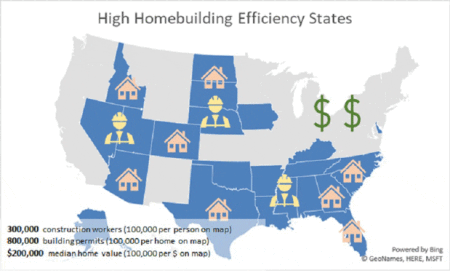Housing affordability is an increasingly important issue around the world. In the United States, both the current and previous presidential administrations have highlighted the dilatory effects that local regulations have on housing prices, and several of the Democratic candidates have also issued housing plans to address the affordability crisis that many in the nation are facing.
It is imperative that housing supply meets or exceeds demand, otherwise prices will rise. The St. Louis Federal Reserve has data on household formation and new housing permits dating back to 1960. In three of the six decades since then, household formation exceeded new housing permits nationally. In those decades, home prices rose by an average of 3.5 percent per year. In the three decades when new housing permits exceeded household formation, home prices rose by less than 1 percent per year.
Since 2014, the United States has averaged 300,000 more household formations per year than residential permits issued, and as a result median home prices have increased 11 percent after inflation. While the number of residential construction workers has increased to over 800,000 in 2018, more housing is still needed. With the country nearing or at full employment, new construction workers may be difficult to find. Can the United States add to its housing stock without increasing the number of residential construction workers?
Improving efficiency in residential homebuilding could help meet this need. A simple way to measure homebuilding efficiency is to look at the number of new residential housing permits (U.S. Census) relative to the number of residential construction workers (Bureau of Labor Statistics). From 1985 to 2005, 2.1 new residential permits were issued for every residential construction worker in the United States. Starting in 2006, however, the ratio fell to 1.82 new residential building permits per worker, and has been lower than that ever since. In 2018, there were about 1.64 permits per worker, well below historic norms.
If the United States could return to the pre-2006 ratio of 2.1 new residential permits for every residential construction worker, there would be almost 400,000 additional housing permits per year, all without adding a single new employee. This would be enough to keep up with demand for new housing.
Increasing efficiency appears to have a positive effect both on the number of homes built and on prices. In 2018, there were 23 states that had permits per worker higher than the national average. Those 23 states produced 800,000 housing units with 300,000 residential construction workers, and the median home price was just under $200,000. In the 27 states with below-average efficiency, there were 530,000 housing units produced by 500,000 workers, with a median home price just over $300,000. Put simply, high-efficiency states are building more housing with fewer workers at a lower price point.
Some state-by-state examples can help illuminate this difference. Since 2010, Idaho has grown more quickly than neighboring Montana. Faster population growth might lead to higher home prices, but Idaho’s 2.36 permits per construction worker is more than double Montana’s 1.13 permits per construction worker. This helps Idaho have a median home price $24,000 lower than Montana, and Idaho is producing almost three times as many houses. Similarly, North Carolina is more efficient than its neighbor Virginia, which helps contribute to an almost $100,000 difference in median home prices and annual construction of almost twice as many residential units. Finally, while both Arizona and Utah are booming economically, Arizona’s better homebuilding efficiency helped create 16,000 more homes and provide a $52,000 median home price advantage over the Beehive State.
Regression analysis on data from all 50 states found that an increase in building efficiency of one-tenth of a unit per worker could reduce median home prices by over $4,500. Controlling for other factors that influence housing prices- such as median household income and population growth- shows a lower but statistically significant impact on median home prices of around $2,500. The price difference between Montana and Idaho in the map above is in line with this result.
At the county level, improving efficiency can also contribute to more housing at lower costs. I live in La Plata County, Colorado. We average 1.12 building permits for every residential worker, and have a median home price of $357,000 (2012-2017 American Community Survey, U.S. Census).
Over the last five years, local builders have created about 340 units of housing each year, but demand has been closer to 500 units of housing per year. If the homebuilding efficiency rate simply increased to the national average, the County would be permitting just over 500 units per year—enough to at least keep up with demand—and median home prices would remain closer to the national average.
With a tight labor market, increasing efficiency may be an important way to grow housing supply and combat rising home prices. Local and state governments would do well to look at their own homebuilding efficiency and engage builders on the question of how to improve it, in order to make housing more attainable for renters and owners alike.
ROGER ZALNERATIS is the economic development manager for the Southern Ute Indian Tribe. Previously, he served as the first executive director of the La Plata Economic Development Alliance in Colorado; the economic development planner for Lawrence, Kansas; and as a research associate in the Community Development Department of the Kansas City Federal Reserve.






